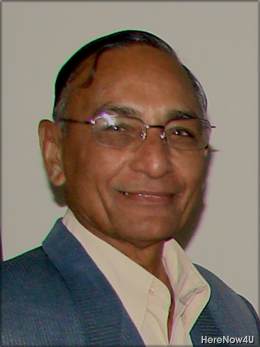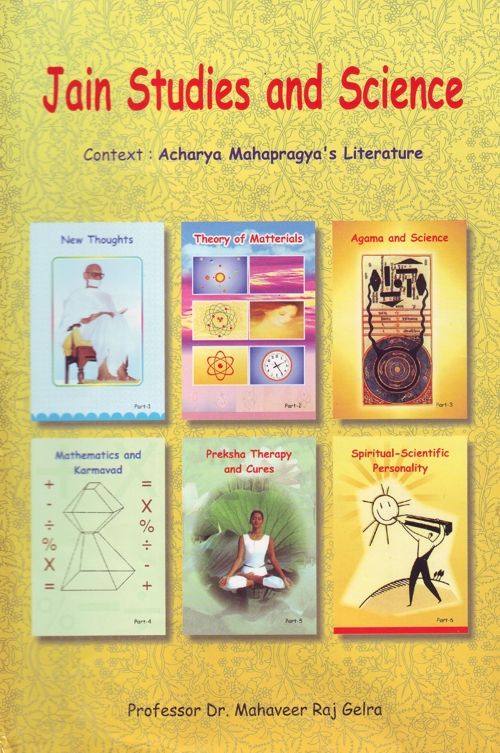Study of human body is divided in two branches - Medical Science and Psychology. While the former presumes all diseases have bacterial, viral or chemical origin, the latter adds another dimension of conscious and subconscious mind affecting the body functioning. Psychologists have established that a depressed state of mind can lead to many physical ailments.
Jain study of human psychology is a trio-logy of Spirit, Karma and Nau-Karma. Mahapragya has quoted several similarities between modern psychology and Jain studies. Some such comparisons are stated here.
1. Human Psyche
Humans have around fourteen autonomic activities programmed in to his physiology. Hunger, thirst, sexual desire, breathing etc. are some physiological activities which take place automatically. Similarly, love, hate, anger, affection, fear, etc. are some spontaneous psychological responses of mind. Medically, these activities and reflexes are the result of basic gene (DNA) programming. From Jain Philosophical view point, we may say we are bonded to our Karmas. Yet both, modern psychologists and ancient Jain philosophers agree that this programming can be modified and evil can be got rid of.
Human weakness, interestingly, is coupled with willpower. We have the capacity to change and grow, without which our evolution would not have been possible. For example, hunger - a basic need triggered by Vedniya Karma -can be over-powered and one can observe fast for days and even months. If determined, a person enjoying all physical comforts can adapt to austerity. According to author, the path of self-improvement can be treaded with Karma transformation.
To be enable to bring about Karma transformation we need to understand the fundamentals of human behaviour, habits, desires and above all human ego. We shall briefly discuss these parameters in the following paragraphs.
1.1. Habits
Medical fraternity believes that the human habits are manifestations of hormonal and chemical activities within the brain. Mahapragya too has found through his experiments of Preksha-Meditation that various behavioural abnormalities can be attributed to the pituitary and thyroid glands. He suggests that the secretions from these glands can be controlled by concentrating on the vision-centre lying between the eye-brows. This kind of meditation, particularly by younger generation, dilutes anger, ego and indiscipline. Mahapragya stresses on targeting young so that they can be moulded before their habits die hard.
1.2. Chitta & Mann
Freud and Jung are pioneers of modern psychological studies and its principles. Their studies revealed that the entire thought process is divided into two parts - conscious and subconscious. They have compared it with an iceberg or an island, where only a miniscule is visible and rest is submerged and hidden. Freud explained various human behaviours on the basis of'depth psychology' which dealt mainly with the subconscious mind. Both these experts, however, treated conscious and subconscious minds as the two faces of same coin. Jain philosophy, however, clearly distinguishes between conscious and subconscious minds.
Conscious mind is termed as 'Dravya Mann' or simply 'Mann' and subconscious mind is called 'BhavaMann' or 'Chitta'. The Mann is described as shrewd, mischievous but weak, while the Chitta is innocent, primitive but powerful. Mann derives its energy from external circumstances and environment. It facilitates the mind to react to the external stimuli. Chitta draws its energy from the karmas of the spirit (atma). The vibrations of the Chitta compel the mind to act in a manner which is pre-written and pre-defined in our karmas. Basically, the Chitta is conduit between the spirit and the Mann. It is through proper meditation that the Chitta can hold the Mann in discipline and mitigate its apparent turbulence (Chanchalta).
2. Emotions
Ego is a part of complex emotional aspect of human psychology, when turns negative, it results in self-righteous, selfish and aggressive behaviour. Emotions, if left untamed are like a bull out on rampage. Emotions are not entirely abstract; they cannot be disciplined by acquired intelligence, but only by balancing the activities of'sympathetic and parasympathetic nervous systems' through the practice of meditation. Medical science has provided a deep insight into the functioning of our brain and nervous system. According to their experiments, right hemisphere controls the left side of the body and vice versa. Each hemisphere has four structurally different parts, of which, frontal lobes are associated with personality and emotions. Mahapragya, from his experience of meditation on self and hundreds of volunteers has established that concentrating on the emotional areas of our frontal lobes helps conquer anger, rage and ego. His experiments have further revealed that during meditation, if our concentration is fully targeted on the hypothalamus, vibrations of higher conscience can be felt. We must recall that hypothalamus is central steering part of the entire endocrine system comprising of hormone secreting glands. Psychological, anatomical and spiritual aspects of different human emotions like fear, anger, desire etc. are elaborated in the following discussions.
2.1. Fear
Perception of danger, real or imaginary, is fear.
Medically, fear induces the secretion of adrenaline and noradrenalin hormones from adrenal glands. The message for such a reaction originates from hypothalamus. This readies the body to highest alertness by altering the blood flow and releasing the stored energy from liver. The body is thus prepared to combat any emergency.
Jains have long back realized that the humans' greatest source of fear is physical suffering - either by way of starvation or by an act of violence. Jain teachings thus concentrate on alleviating these fears. They have an elaborate methodology of fasting which helps overcome the apprehension of starvation. Similarly they insist on the theory of non-violence to win over the insecurity of assault. Jain literature is full of such events where Lord Mahavira remained unscathed even when assaulted by snakes, elephants, lions and humans.
2.2. Anger and Violence are Results of Primordial Brain
Jain Sthanang Sutra contains discussions on anger. Mahapragya has described the intricacies of anger on psychological grounds. Referring to Sthanang Sutra, he states that the anger is mainly provoked by following ways -
- Proactive: Self inflicted. Anger can be triggered by one's state of mind itself. This results in frustration and dissatisfaction.
- Reactive: Induced by the external and environmental factors. This type of anger results in aggression.
- Di-active: When both proactive and reactive factors are responsible for anger. This often culminates in violent behaviour.
- Passive: When none of the above factor is present, yet the karmic reasons give rise to anger. This may result in misery and depression.
Mahapragya analyses that this classification underlines a fact that anger is not the steady state of mind, rather it is an excited state triggered under certain circumstances. This classical philosophy is substantiated by the modern psychology.
Medical Experiments in this field have revealed interesting facts. According to the pioneering experiments of Dr. Delgado the state of mind can be altered from tranquil to agitated and vice versa by stimulating the designated and pre defined points and areas of the human brain. In one of his experiments, he was successful in initiating a quarrel among the peaceful group of monkeys by sending mild electrical impulses to their minds through the electrodes fitted on their heads. In a similar experiment the converse was proved. Here, a hungry cat was made to coexist peacefully with a mouse as her senses of appetite were inhibited by the electrical signals. With the help of such experiments on bulls, other animals and humans, scientists have developed complete topography of the human mind. Psychologists have used this information to develop a method where no external electrical stimulation is required, instead the person is taught to enhance his own determination using the method of auto-suggestion.
2.3. Sexual Desires
Humans desire love, affection, attention and respect from others. Amongst all these desires, the human sexual desire is the most enigmatic. While all the rest of desires are socially accepted and treated legitimate, sexual desire is yet to be classified as good or bad. While all religions emphasize on curbing and treat it as taboo, advocates of full freedom are also aplenty. Conflicting hard line views have painted a blurred picture so far. With advancements in medical sciences we have now being better able to understand the role of internal glands and hormonal secretions behind the sexual drive. At the same time, incessant experiments by Mahapragya with Preksha Meditation have revealed effective ways to tackle the hormonal imbalance.
2.3.1. Physiological Explanation of Sexual Desires
Pineal glands secrete two important hormones - serotonin and melatonin. Serotonin in conjunction with dopamine and noradrelenin is responsible for appetite, lust, memory and learning, temperature regulation, mood, behaviour, cardiovascular function, endocrine regulation and depression. There is no other physiological chemical known which controls so many human emotions and body functions. On the other hand, Melatonin is known to suppress lust and its deficiency may lead to seasonal affective disorders (SAD). Noble Prize winner Julius Axelrod has performed many conclusive experiments to reveal the role of melatonin in regulating sleep-wake cycles (circadian rhythms). Normally, production of melatonin is inhibited by day-light and permitted by darkness. In essence, our biological clock along with various environmental triggers available to the brain create cyclic pattern of lust and desire. Physiologically, sexual desire is just similar to appetite and breath programmed in our DNA. This understanding has resulted in manufacture of serotonin based drugs containing serotonin reuptake inhibitors which controls and mitigates negative emotions including depression. We shall soon find out in following discussions that control of hormones and neurotransmitters through spiritual means is not just a fiction but is a physiological fact.
2.3.2. Psychological Explanation of Sexual Desires
Sigmund Freud, first time ever took the craving for reproduction to the psychological level. He associated the sexual drive to the creativity and advocated open satiety of lust. He argued that sexual pleasure is an ever lasting basic need and all humans tend to satisfy it by whatever means. Another psychologist, Adler arrived at diagonally opposite conclusion and proclaimed that the desire to reproduce is not as much for pleasure as it is for consolidation of social strength. A third view came from Hume, who contradicted both Adler and Freud. According to him, the basic driving force of a human is neither desire to reproduce nor accumulation of energy, but it is desire to develop one's own personality. While Freudian view point tends to make a human being hostage of desires, the Adler's view has a danger of creating a highly competitive society having strength as the only benchmark of human personality. Hume's view is very close to spiritual way of thinking.
2.3.3. Spiritual Explanation of Sexual Desires
According to Jainism, it is rising of Mohniya Karma and the micro activities of Emotion-Centre. Mahapragya has unified the scientific concept with traditional one. He states that our Command-Centre (Agya-chakra also called as third-eye) is same as hypothalamus and by concentrating on this centre, secretions of pineal and pituitary glands can be inhibited to act upon the gonads thereby annulling the sex desire. Recently, Bio-electrostatic research Centre, University of Southampton, UK has established through scientific research and documented accounts of personal experiences that there are striking similarities between religious mystical experiences and the effects of serotonergic drugs like LSD. This opens avenues of research into the meditation practices and the wealth of knowledge on consciousness and the way we perceive the world.
3. Refinement of Psyche
Having discussed various physiological, psychological and spiritual aspects of human emotions like, anger, fear, desire etc., we conclude that our destructive and negative thoughts and emotions need to be reigned in. Immediate methods proposed by Mahapragya are - strengthening of willpower and sex education. Ultimate method, according to him is the evolution of refined brain.
3.1. Willpower - Experiments with Emotion
Yoga practitioners have known the importance of will power for ages. They have established that humans can reap rich health benefits by directing their emotions and energy on various body chakras. Modern psychologists refer this technique as auto-suggestion. They have developed an autogenic treatment system. In this method the patient is induced to believe that he/she is free of the ailment.
3.2. Sex-Education and Self Discipline
Giving health its due importance, it is established that food and sex must be refined and restrained. Indiscriminate abuse of both leads to several diseases, some of which could be life threatening. Mahapragya insists that a proper sex education can help prevention, but self-discipline and restraint must be taught along with it. This will further reinforce the prevention and protection.
4. Evolution of Intellect and Proposed Structure of Refined Brain
According to the triune brain theory developed by Dr. Paul MacLean, Chief of Brain Evolution and Behaviour at the National Institutes of Health, humans have three brains, not just one. Throughout its evolution, the human brain has acquired three components that progressively appeared and became superimposed, just like in an archaeological site: the oldest, located underneath and to the back; the next one, resting on an intermediate position and the most recent, situated on top and to the front. They are, respectively:
1 - The archipallium or primitive (reptilian) brain, comprising the structures of the brain stem - medulla, pons, cerebellum, mesencephalon, the oldest basal nuclei - the globus pallidus and the olfactory bulbs. It corresponds to the reptile brain, also called 'R-complex', by the famous neuroscientist Paul MacLean.
2 - The paleopallium or intermediate (old mammalian) brain, comprising the structures of the limbic system. It corresponds to the brain of the inferior mammals. It affects moods, emotions and bodily functions. It is also referred to as emotional centre and conscious system.
3 - The neopallium, also known as the superior or rational (new mammalian) brain, comprises almost the whole (about 80 percent) of the hemispheres made up of a more recent type of cortex, called neocortex. It corresponds to the brain of the superior mammals, including the primates and, ultimately, the human species. It affects our creativity and our ability to learn.
In the process of evolution, some of these reptilian functions were lost or minimized. Mahapragya surmises that if the reflex responses of our age-old animal brain to the various stimuli like odours, approach, attack, fight and mating can be diverted to the limbic or neo-cortex brain, all violence, hatred and aggression will end. Survival of fittest will no longer remain true. A new species of mankind will evolve. We have seen that during the evolution of millions of years human anatomy has undergone several phases of change adapting to the environment. This process is still continuing. For example, Dentists toda> say that our wisdom teeth may disappear 200 years down the lane as they serve no useful purpose in chewing. Similarly, religious leaders like Mahapragya rightly point out that by practicing spirituality, the reptilian brain will become redundant and in due course of time our neocortex brain will get rid of it. Let us all work together in this direction so that a violence and war free society no longer remains a mere dream.

 Dr. Mahavir Raj Gelra
Dr. Mahavir Raj Gelra

